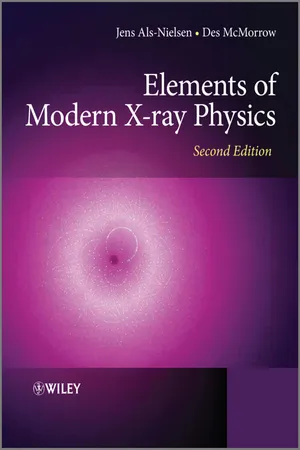
- English
- ePUB (mobile friendly)
- Available on iOS & Android
Elements of Modern X-ray Physics
About this book
Eagerly awaited, this second edition of a best-selling text comprehensively describes from a modern perspective the basics of x-ray physics as well as the completely new opportunities offered by synchrotron radiation. Written by internationally acclaimed authors, the style of the book is to develop the basic physical principles without obscuring them with excessive mathematics.
The second edition differs substantially from the first edition, with over 30% new material, including:
- A new chapter on non-crystalline diffraction - designed to appeal to the large community who study the structure of liquids, glasses, and most importantly polymers and bio-molecules
- A new chapter on x-ray imaging - developed in close cooperation with many of the leading experts in the field
- Two new chapters covering non-crystalline diffraction and imaging
- Many important changes to various sections in the book have been made with a view to improving the exposition
- Four-colour representation throughout the text to clarify key concepts
- Extensive problems after each chapter
There is also supplementary book material for this title available online (http://booksupport.wiley.com).
Praise for the previous edition:
"The publication of Jens Als-Nielsen and Des McMorrow's Elements of Modern X-ray Physics is a defining moment in the field of synchrotron radiation... a welcome addition to the bookshelves of synchrotron–radiation professionals and students alike.... The text is now my personal choice for teaching x-ray physics...."
—Physics Today, 2002
Frequently asked questions
- Essential is ideal for learners and professionals who enjoy exploring a wide range of subjects. Access the Essential Library with 800,000+ trusted titles and best-sellers across business, personal growth, and the humanities. Includes unlimited reading time and Standard Read Aloud voice.
- Complete: Perfect for advanced learners and researchers needing full, unrestricted access. Unlock 1.4M+ books across hundreds of subjects, including academic and specialized titles. The Complete Plan also includes advanced features like Premium Read Aloud and Research Assistant.
Please note we cannot support devices running on iOS 13 and Android 7 or earlier. Learn more about using the app.
Information



Table of contents
- Cover
- Half Title page
- Title page
- Copyright page
- Preface
- Preface to the first edition
- Acknowledgements from the first edition
- Notes on the use of this book
- Chapter 1: X-rays and their interaction with matter
- Chapter 2: Sources
- Chapter 3: Refraction and reflection from interfaces
- Chapter 4: Kinematical scattering I: non-crystalline materials
- Chapter 5: Kinematical scattering II: crystalline order
- Chapter 6: Diffraction by perfect crystals
- Chapter 7: Photoelectric absorption
- Chapter 8: Resonant scattering
- Chapter 9: Imaging
- A: Scattering and absorption cross-sections
- B: Classical electric dipole radiation
- C: Quantization of the electromagnetic field
- D: Gaussian statistics
- E: Fourier transforms
- F: Comparison of X-rays with neutrons
- G: MATLAB® computer programs
- H: Answers to exercises and hints
- Bibliography
- Index
- List of symbols
- Wiley End User License Agreement